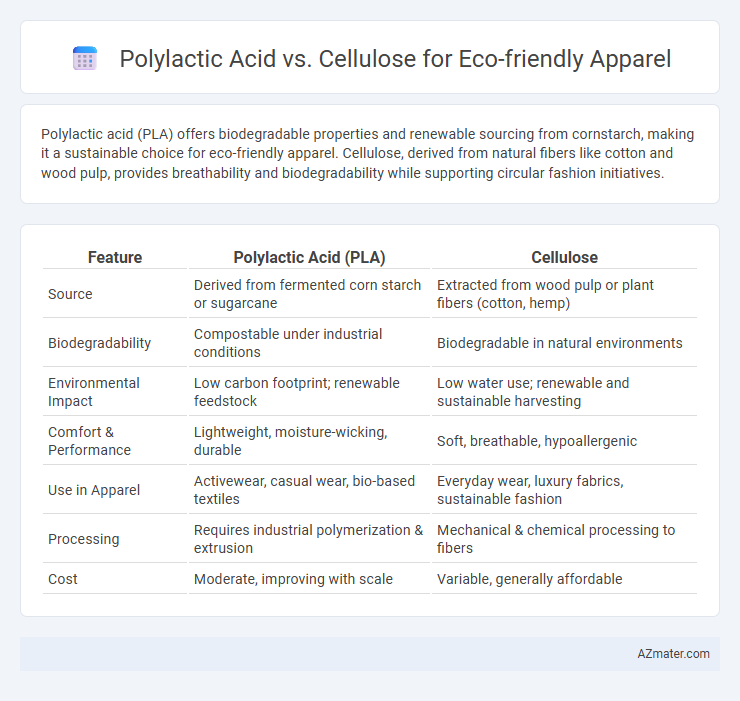Polylactic acid (PLA) offers biodegradable properties and renewable sourcing from cornstarch, making it a sustainable choice for eco-friendly apparel. Cellulose, derived from natural fibers like cotton and wood pulp, provides breathability and biodegradability while supporting circular fashion initiatives.
Table of Comparison
| Feature | Polylactic Acid (PLA) | Cellulose |
|---|---|---|
| Source | Derived from fermented corn starch or sugarcane | Extracted from wood pulp or plant fibers (cotton, hemp) |
| Biodegradability | Compostable under industrial conditions | Biodegradable in natural environments |
| Environmental Impact | Low carbon footprint; renewable feedstock | Low water use; renewable and sustainable harvesting |
| Comfort & Performance | Lightweight, moisture-wicking, durable | Soft, breathable, hypoallergenic |
| Use in Apparel | Activewear, casual wear, bio-based textiles | Everyday wear, luxury fabrics, sustainable fashion |
| Processing | Requires industrial polymerization & extrusion | Mechanical & chemical processing to fibers |
| Cost | Moderate, improving with scale | Variable, generally affordable |
Introduction to Sustainable Fibers in Fashion
Polylactic acid (PLA) and cellulose represent two pivotal materials in the shift towards sustainable fibers for eco-friendly apparel, each offering distinct environmental benefits. PLA, derived from renewable corn starch or sugarcane, provides biodegradability and reduced carbon emissions compared to traditional synthetic fibers. Cellulose, sourced from wood pulp or cotton linters, contributes eco-friendliness through its natural origin, biodegradability, and compatibility with closed-loop recycling processes in fashion manufacturing.
What is Polylactic Acid (PLA)?
Polylactic Acid (PLA) is a biodegradable thermoplastic derived from renewable resources such as corn starch or sugarcane, making it a sustainable alternative to conventional petrochemical-based fibers. PLA offers excellent moisture-wicking and breathability properties, which contribute to comfort in eco-friendly apparel. Compared to cellulose fibers like cotton or lyocell, PLA provides a lower carbon footprint during production, enhancing its appeal for environmentally conscious fashion brands.
What is Cellulose Fiber?
Cellulose fiber, derived from plant sources such as wood pulp and cotton, is a natural, biodegradable material renowned for its sustainability in eco-friendly apparel. It offers excellent breathability, moisture absorption, and softness, making it ideal for comfortable and environmentally responsible clothing. Compared to polylactic acid (PLA), cellulose fibers have a longer history of use and are fully renewable, decomposing naturally without harmful residues.
Environmental Impact: PLA vs Cellulose
Polylactic acid (PLA) fibers, derived from fermented plant starches such as corn, offer biodegradability and lower greenhouse gas emissions compared to conventional synthetic fibers but require industrial composting conditions to break down effectively. Cellulose-based fibers, including cotton and regenerated fibers like lyocell, are renewable, biodegradable, and generally have a lower water and chemical footprint, especially when produced using closed-loop processes that recycle solvents. Life cycle assessments indicate cellulose fibers often demonstrate a more favorable environmental impact than PLA, particularly in terms of water use and end-of-life biodegradation in natural environments.
Biodegradability and Compostability Comparison
Polylactic acid (PLA) and cellulose fibers both offer eco-friendly options for apparel, with PLA derived from renewable resources like corn starch and cellulose primarily sourced from plant cell walls. PLA exhibits strong biodegradability under industrial composting conditions, breaking down within 1 to 3 months, whereas cellulose is naturally biodegradable and compostable in both industrial and home compost environments, typically decomposing within weeks. The compostability of cellulose fibers is more versatile, thriving across broader environmental settings, while PLA requires controlled conditions to ensure efficient breakdown and minimize microplastic residue.
Source Materials and Renewability
Polylactic acid (PLA) is derived from renewable resources like corn starch or sugarcane, offering a sustainable alternative with its biodegradability and fewer environmental pollutants during production. Cellulose, extracted primarily from wood pulp or cotton, is a naturally abundant polymer known for its excellent biodegradability and renewability, making it a staple in eco-friendly textiles. Both materials leverage plant-based sources, but cellulose often requires less intensive chemical processing compared to PLA, enhancing its overall eco-credibility in sustainable apparel manufacturing.
Performance and Durability in Apparel
Polylactic acid (PLA) fibers offer high tensile strength and moisture-wicking properties, making them suitable for activewear with good biodegradability. Cellulose-based fibers, such as lyocell and viscose, provide excellent breathability and softness but tend to have moderate durability under repeated stress and washing. PLA generally outperforms cellulose in maintaining structural integrity over time, making it preferable for high-performance eco-friendly apparel applications.
Production Processes and Energy Use
Polylactic acid (PLA) production involves fermenting renewable resources like corn starch, requiring moderate energy for polymerization and extrusion. Cellulose-based fibers, derived from wood pulp, undergo chemical or mechanical treatments with varying energy intensities depending on the method, often lower than PLA. Energy consumption in PLA tends to be higher due to its synthetic processing steps, while cellulose benefits from more established, less energy-intensive extraction techniques.
Cost and Market Adoption
Polylactic acid (PLA) offers a competitive cost advantage over cellulose fibers due to its efficient fermentation-based production from renewable resources like corn starch, enabling scalable manufacturing processes. Cellulose fibers, such as lyocell or viscose, often incur higher costs due to intensive chemical treatments and sourcing from wood pulp, impacting their price point in the eco-friendly apparel market. Market adoption trends indicate PLA is gaining traction in performance apparel for its biodegradability and moisture-wicking properties, whereas cellulose maintains strong demand in mainstream eco-conscious fashion for its natural fiber feel and sustainability credentials.
Future Prospects for PLA and Cellulose in Eco-Friendly Apparel
Polylactic acid (PLA) and cellulose-based fibers both offer promising futures in eco-friendly apparel due to their renewable origins and biodegradability. Advances in PLA production aim to improve tensile strength and moisture management, making it more competitive with conventional fibers, while innovations in cellulose processing enhance softness and durability, expanding its application range. Integration of bio-based additives and recycling technologies will further boost sustainability credentials and market viability for both materials in the fashion industry.

Infographic: Polylactic acid vs Cellulose for Eco-friendly apparel
 azmater.com
azmater.com